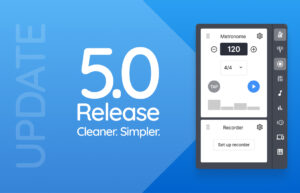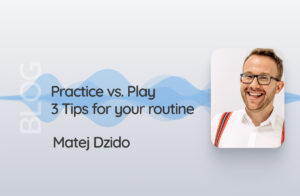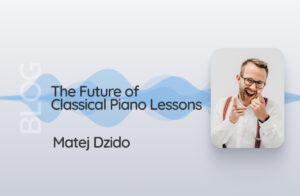by Aloisia Dauer
The Easter holidays are just around the corner and that means time off from music lessons as well. But what happens when practising with the instrument is paused for a longer period of time? How can the holidays be divided up so that students can recover but also not forget everything from music lessons? In this blog post, I would like to show how students can be motivated to practice even during the holidays.
Why regular practice is important
Learning an instrument is a lot about memorising movement patterns. In order to develop the motor abilities for a particular instrument, a high number of repetitions is needed – just like in sports. The more often a movement is repeated, the better it is imprinted in muscle memory and the muscles become stronger over time. As soon as we pause the training, the brain forgets the first micro-movements in the muscles. With longer breaks, muscles are then also reduced again. Eventually, fitness suffers as well. What is valid for the athlete is just as valid for the musician. Therefore, too long breaks in training or practising should be avoided.
How to schedule practising into the holidays
In my lessons, it has proven useful to draw up a practice plan together with the students in the last lesson before the holidays. I ask them what their holiday plans are and how many days they will be at home or away. Based on this, we choose the pieces of music for the holiday period. It is not always necessary to rehearse something new. Holidays are a good time for repeating technical exercises, playing favourite songs or rehearsing a familiar piece of music. With younger pupils, I also consult with the parents. On the one hand, to get reliable information about the holiday planning. After all, the children don’t always know everything! On the other hand, I explain to them the importance of regular practice.
Practising without an instrument
Of course, this assumes that the instrument is available. What to do if the family is away for the whole holiday period? The violin is quickly kept in the car. It’s a different story with the piano or drums. But here, too, there are suitable alternatives. Drum students, for example, can buy a practice pad. This is usually only the size of a dinner plate and, together with a few sticks, fits in any backpack. Paradiddle and other technical exercises can be practised on it. String players, for example, have the option of practising finger and bow exercises with a pen. In addition, students can always learn music theory, listen to and analyse pieces, sing the melodies to be practised or practise them mentally. This is a great way to stay in a routine even during the holidays.
How do I create a practice schedule?
Creating a practice schedule and finding the right time to practice is very individual. It depends on the instrument and the level of training. In the first years of lessons, ideally, the instrument should be played three to four times a week for about 10 to 15 minutes. This regularity is important because, especially in the beginning, it is all about learning movement patterns while playing. However, it does not always have to be the most difficult exercise, because free improvisation and experimental practice also count, especially on the unmotivated days. If students have lessons of more than 30 minutes and the pieces become longer, then the practice time automatically becomes longer. However, a short break should be planned after 45 minutes at least. Longer practice times depend on the goals of the students. Of course, longer sessions offer more time to work on more complex exercises. In case of doubt, however, it is better to practise regularly and briefly rather than infrequently and for a long time! Consistency in practice sessions is the key to preventing unlearning and eventually making further progress. A practice schedule can be a mix of repetitions of already known technical exercises for reassurance. It can also be a practice of continuing to learn a piece that has already been started or, for learning by heart, for example.
The holidays are a good time to experiment with the best time of day. I recommend using a time slot when students have the most concentration and energy. These should be scheduled and discussed so that they do not conflict with other holiday activities. Without good planning, there is a great chance that the day will fly by and there will be no energy left in the evening. Parents may and should even remind their children to practise. Most children, especially those of school age, need the reminder. But don’t worry, that usually doesn’t mean they don’t enjoy playing their instrument!
Support practice with digital learning aids
Digital learning tools are especially useful during the holiday season because they can help students practise at home. In addition, skills can be practised and intensified that are less represented in other lessons. The music apps from doozzoo are ideal for this because the students can access them directly on the homepage, even without online lessons. In the following, I describe some of the tools and their use.
Practising with the tuner
Most instruments need to be tuned before they can be played, and students should learn and practise this on their own right from the beginning. In doozzoo there is also the possibility to tune your instrument. One way is to play a note to the tuner. The indicator then displays which note is being played and whether it is too high or too low.
However, especially in ensembles such as orchestras, tuning is done with a tuning tone. That’s why I recommend the following exercise: switch on the tuner and select the tuning tone. Now the student has to tune the instrument until both notes sound the same. If he/she thinks he/she has tuned correctly, he/she can then switch the tuner to listening mode. Now the tuner will show whether it has been tuned correctly.
String instruments, such as the violin, go one step further. Here, only the standard concert pitch A is tuned. This means that the A-string is tuned first. The other strings are tuned in fifths or, in the case of the contrabass, in fourths by playing both strings at the same time or one after the other. Here, too, string players can check their tuning afterwards with the tuning device.
Keeping tempo to the metronome
Students tend to practise and play pieces at an uneven tempo. In difficult passages they often slow down, in easy passages the tempo is increased. With the metronome they can practise playing at a steady tempo. Difficult phrases in particular must first be learned and understood at a slow tempo. The students can then gradually increase the speed until the target tempo is reached. For each instrument there are exercises to train certain movement patterns, such as rudiments or scales. I recommend picking out a few of these exercises and defining a target tempo for each.
Music theory and ear training with the keyboard
The integrated piano keyboard in doozzoo is very suitable for music theory and ear training. Such exercises are often cut short in the school weeks because there is often no time left over in lessons for them. However, knowledge of music theory is an important basis, no matter which instrument is being learned. Pupils can do music theory exercises on the piano keyboard and learn how to read music notes, intervals, chords and scales and how to play them on the piano. Especially for young students, there are recommended theory books with tasks that are age-appropriate, such as “Abenteuer Musiktheorie”, “Notenrätsel mit Dobi” or “Harmonielehre im Selbststudium” by T. Krämer for advanced students. The piano keyboard is very helpful for solving the exercises.
Self-check with the recorder
It is always difficult for students to evaluate themselves while playing at the same time. In class, this is done by the teacher. With doozzoo it is possible to record yourself playing a song in good quality. Have your students record themselves playing. Afterwards they should analyse what can be done better or which parts need to be repeated.
A recording can also be used as digital homework. The recordings can be easily shared with the teacher via the media library. In this way, you also define a learning goal at the same time.
Many of my colleagues report that their students have a lot of fun making such recordings. Their ambition to create a good shot motivates them to practise even more.
Everything in the media library
Students always have access to sheet music and other practice material in the media library. I recommend taking another look here. Do my students have everything they need? Because this is a cloud-based solution, it doesn’t matter which device is used during the holidays. Even on their Spanish aunt’s tablet, students have everything with them. My tip: Record an exercise or a piece of music with the recorder as a reference for the students and upload it. This way they can learn both visually and auditorily.
The most important thing comes at the end!
In this spirit, together with the doozzoo team, I wish everyone a wonderful holiday with relaxing days and lots of fun making music.
About the author

Aloisia Dauer is a violinist, teacher at the Musikschule Grünwald e.V., violin consultant for the Bavarian Sing- und Musikschulen and founder of Your Music Mind. She completed her education with excellence at the Mozarteum University in Salzburg with Prof. Igor Ozim and Prof. Harald Herzl, where she was already accepted as a young student. Her great passion is chamber music. She performs with renowned artists at international festivals and concerts. In addition to her concert activities, she teaches her violin class and as a lecturer at international master classes. She also works with educational companies such as doozzoo by C. Bechstein, Ernani GmbH and with music publishers. In 2019, she received an award from BR-Klassik as “Bavaria’s most popular music teacher”.
Your Music Mind was created with the desire to create a platform around the topic of practising, with learning guides such as the practising diary, blog, videos, interviews with musicians and workshops, in order to give music students and parents practical practising strategies for practising at home and to support them in their learning. So that students enjoy making music and practising!











